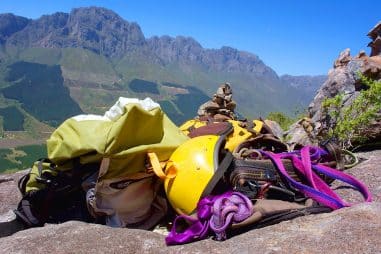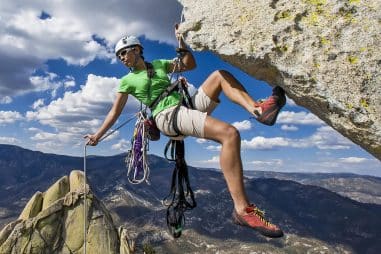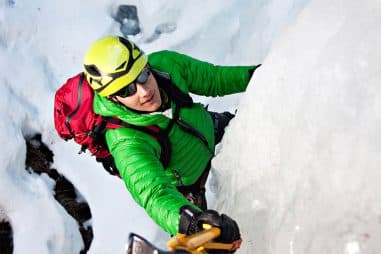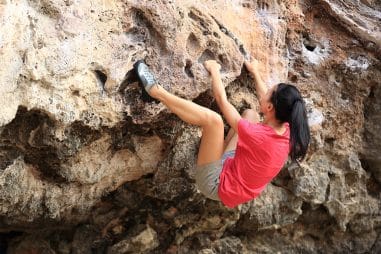If you think abseiling is somehow easier than climbing, then think again. Abseiling is another climbing method that will surely keep you on your feet (get it?).
What is Abseiling?
Abseiling is an activity where you descend down a mountain, cliff, or man-made structure using a rope in a controlled condition or a controlled manner.
Simply put, abseiling is the opposite of climbing. Climbers use this technique when it is too dangerous to climb down a cliff without any protection
Why is it Called Abseiling?
Abseiling is from the German word abseilen which means to rope down. It is called as such because climbers often use this technique in climbing down near-vertical slopes.
Not only is this technique done by climbers, mountaineers, or canyoners, but search and rescue personnel often use this method in descending down dangerous cliffs or areas.
Who Invented Abseiling?
Jean Estéril Charlet is the first person to have abseiled and is often recognized as the inventor of the technique.
Charlet lived as a guide in the Chamonix region of France. It took him several attempts before he perfected abseiling.
When Was Abseiling Invented?
Jean Estéril Charlet was known to have first used abseiling in 1876. He used this method during his failed solo attempt in Petit Pru.
He continued to practice abseiling, but it was only in 1879 that he perfected the descent in the presence of two other guides named Frédéric Folliguet and Prosper Payot which are both Chamonix guides like Charlet.
How Do You Do Abseiling?
When you are abseiling, you are basically hanging from a rope attached to the top of a cliff, mountain, or man-made drop. The speed of your drop depends on the friction that you create between you and the rope.
Now, you would usually want to come down faster, right? Wrong.
If you are hanging from a 50-feet drop, it’s better for you to descend slower which means you have to create enough friction to keep you safe.
Remember that when abseiling, speed is really not an option. You should be able to abseil yourself down safely at just the right amount of speed.
Is Abseiling the Same as Rappelling?
Abseiling and rappelling are essentially the same in which they both mean using a rope and a control device to climb down.
Both abseiling and rappelling have European origins with abseiling coming from a German word and rappelling from a French word.
What is the Difference Between Abseiling and Rappelling?
A difference between these climbing methods is in who calls what. Abseiling and rappelling are used interchangeably in some countries.
But in the UK and other European countries with emphasis on Germany, the preferred term is abseiling. Meanwhile, in the United States of America and Canada, climbers commonly use the word rappelling.
What is the Difference Between Abseiling and Rock Climbing?
Abseiling and rock climbing may look the same in pictures, but they have a lot of differences.
| Abseiling | Rock Climbing |
|
|
Is Abseiling A Sport?
Abseiling is a sport in its own right. Some even consider it as an adventure sport and not just a rock-climbing sport.
Some climbers even regard the activity as more dangerous than other climbing sports because of how it being practiced.
Is Abseiling an Extreme Sport?
Many thrill-seekers are considering abseiling as one of the most popular extreme sport in the world. It has consistently been gaining more and more enthusiasts and hobbyists over the years.
One may consider abseiling an extreme sport for one of the following reasons:
- It deals with crazy heights.
- It has a high-risk element.
- It breaks your physical and mental boundaries and pushes you to your limit.
- It can be done anywhere.
- It has a fear factor.
How Dangerous is Abseiling?
Although abseiling usually is a safe activity, it also can be very dangerous at times. Even when you’re being supervised by qualified instructors, unforeseen mishaps can happen.
If proper precautions aren’t taken, this activity can have many deadly repercussions.
Why is Abseiling So Dangerous?
Here are some reasons why abseiling can be dangerous:
- The structure from which you are descending from may not be structurally sound: Whether you are abseiling from a cliff or the side of a building, parts of it may come loose and fall on your head.
- You may face difficulties with your rope: You can never be too sure with your rope because it may end up getting cut on a jagged point, might be tangled, and might even break on your descent.
- Wrong handling of your gears: You may not have correctly tied your knots or the harness wasn’t attached securely and properly.
- Descending too fast: As you already know, speed is a big factor in abseiling. Descending too fast may result in rope burns which can be severe.
- Dangerous landing: If you descend too fast, you might miscalculate your landing. This may result in twisted ankles or dislocated knees.
How Do You Abseil Safely?
Abseiling is generally a fun sport if practiced carefully and safely. Here are some tips on how to enjoy your abseiling adventure:
- Never abseil alone
- If possible, bring a qualified instructor
- Assess the location
- Set your anchor correctly and safely
- Assess your equipment
- Fit your equipment securely and properly
- Make sure that you are always aware of your surroundings
- Descend down using a safe speed (not too fast and not too slow)
How Old Do You Have To Be To Abseil?
There is no minimum age limit on how early you can start abseiling, but qualified instructors recommend being at least eight (8) years old. Some even start their kids younger.
No matter what age, you have to make sure that wherever your child is doing it, a qualified instructor is near. You kids should also be very comfortable with heights when you introduce them to the sport.
What Equipment Do I Need for Abseiling?
Here’s a short list of gear that are essential for abseiling:
- Rope and rope protector
- Anchors
- Belay Device
- Harness
- Carabiners
- Accessory Cord
- Helmet
- Gloves
- Climbing shoes
What Type of Rope is Used for Abseiling?
Static rope is the best type to get if you are going abseiling. It is the best for many reasons including the following:
- Static rope has minimal stretch.
- Static rope makes your descent more stable and controlled.
- Static rope also ensures a smooth descent.
- Static rope has a very minimal bounce rate.
Can You Abseil on a Dynamic Rope?
It is not advisable to use dynamic ropes for abseiling because of its bounce rate. When you’re abseiling, it is best to use a rope that is can be taut like a static rope as the minimal stretch keeps it more secure than that of dynamic ropes.
The bounce factor of a dynamic rope can be a safety hazard while you are abseiling. Likewise, it’s stretchability makes it unsuitable for many activities.
Dynamic ropes, however, are best used while rock climbing, mountaineering, or ice climbing.
How Do You Abseil With a Carabiner?
Abseiling using a carabiner would be the next best thing to do if you accidentally drop your belaying device. There are two methods on how to use a carabiner or carabiners when abseiling.
Carabiner Brake Method
This works best with 4 to 6 oval carabiners and either a single strand or double strand of rope. This is how you abseil using the carabiner brake method.
Step 1: Set up your rope. The way you set up your rope depends on the kind that you are using. If you are using a single strand, you should tie one end to the anchor point. On the other hand, if you are using a double strand, you should pass the rope through the anchor point instead of just tying it.
Step 2: Attach your carabiner to your harness’ belay loop. The number of carabiners will depend on the kind that you have with you. If you have locking carabiners, you can just use one. If you have non-locking carabiners, you better use two.
Step 3: Clip another set of carabiners to the one attached to your harness. It doesn’t matter what kind you have; it is a rule of thumb to use two carabiners in this step. When you attach the carabiners and you open the gates, they should form an “X”.
Step 4: While facing the anchor point, pass a bight of rope through the second set of carabiners.
Step 5: Take another carabiner and clip this across the second set of carabiners. This new addition should be placed beneath the bight of rope that you just haul through.
Step 6: Tighten the ropes through the carabiners by pulling the ropes on opposite ends. Make sure that your ropes are straight and stable before abseiling down.
Munter Hitch Method
Also known as the crossing hitch or the Italian hitch, this method is best used when you don’t have enough carabiners for the carabiner brake method. If you opt to use this method, you would only need one locking carabiner or two non-locking carabiners. This is how you abseil using the munter hitch method.
Step 1: Set up your rope the same way you would in the carabiner method. If you are using a single strand, tie one end to the anchor point; if you are using a double strand, pass the rope through the anchor point.
Step 2: Attach your carabiners to your harness’ belay loop. Make sure that the gates of your two non-locking carabiners will form an “X” and not be parallel to each other.
Step 3: Create the munter hitch. With your hands crossed and facing down, hold the rope straight in front of you. Bring your first towards each other like doing a fist bump before bringing the two loops from your hands then clip the loops into the carabiner. The final step is to check if the rope runs across the spine of the carabiner. Check if you did the right knot before abseiling down.
Can You Abseil With a Belay Device?
You can definitely abseil with the majority of belay devices out in the market. Here are some of them that are best used for abseiling:
- Tubular Belay Devices or Air Traffic Controller (ATC): Watch out on the break on this one because this can be locked off mid-rappel so properly secure the brake hand on the rope. It also only works with certain rope sizes.
- Figure 8 Style: Some advantages of using this device are a) it is easy to set up, b) it dissipates heat easily, c) friction is apply smoothly throughout the device, d) it can be locked off mid-rappel, e) it makes for a very comfortable descent.
Can You Abseil With a GriGri?
First off, GriGri is a Petzi-manufactured assisted braking device, and yes, you can use a GriGri when abseiling because it was designed to help secure you while abseiling.
In order to safely use a GriGri on your descent, you must first have proper knowledge and training in setting this up.
How Do You Get the Rope Back After Abseiling?
There are different ways on how to get your rope back after abseiling.
- Abseil down on both ends of the rope: It is also considered as one of the safer ways to descend because you use your own weight as the counterbalance. First, tie stopper knots on the rope ends and drop it down making sure that both ends reach the ground. Once you reach the end of your rope, attach yourself temporarily to the wall before getting off the anchor then pull the other side of the rope.
- Use your carabiner or descender: If you plan to use this method, you will only be descending on one end of the rope while the other end is jammed with a metal object in which the rope can pass through. You need to back this system up to be safe and secured in your descent. Once you’re on the ground, you may use a pull cord to retrieve the rope.
What Do You Wear for Abseiling?
There are no rules on what or what not to wear when abseiling but it’s best to wear slim fitting and stretchable clothing. Choose sturdy fabrics (like cotton) which will provide more protection. Spandex is becoming popular nowadays as a go-to abseiling outfit.
Choose pants and shorts that have diamond crotch or gusseted crotch as this will prevent ripping. This is very important because you’ll be moving in a hundred different directions.
Also, invest in durable climbing shoes as this will be very helpful in your footwork while abseiling.








